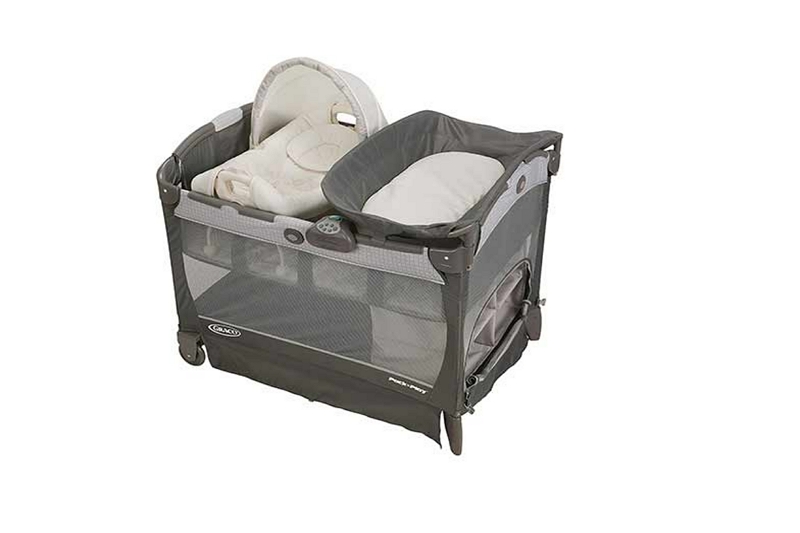What is the smallest playpen available? The smallest playpen available is the Babybjorn Mini Portable Playard.
It folds into a carrying case that can be stored in closets or other small spaces when not in use. The product dimensions are 34 x 28 inches, and it weighs 15 pounds without any additional items attached to it for storage purposes.

This play yard has mesh walls surrounding it all around, making sure your little one gets plenty of ventilation while staying inside the pen at the same time.
The mattress pad included with this set fits right on top of standard-sized crib mattes so you don’t have to look too far if they need an extra sleeping area during nap times or bedtime routines each night before sleep comes about again later on down the line!
There is also a carrying strap included with this purchase so you can take it practically anywhere you go without having to worry about lugging around a lot of extra weight on your end.
The next smallest playpen available is the Graco Pack ‘n Play On The Go Playard. This particular model is designed for travel and outdoor use, as it comes equipped with a frame that easily collapses down into a small carrying case that will fit in any standard-sized suitcase or bag.
It’s important to note that this pen does not come with a mattress, so if you are looking for something soft and comfortable for your child to sleep on while away from home then you may need to look elsewhere – though there are plenty of other options out there with extra features to make up for this! If you are looking for a playpen that is designed with portability in mind, then this may be the way to go.
The Graco Pack ‘n Play On The Go Playard comes equipped with plenty of ventilation panels around it on all sides so your baby can get fresh air while staying safe and secure at the same time.
What are the benefits of using a playpen?
-Playpens give babies a designated space to safely play without having to worry about them getting into trouble or crawling off to explore other areas of your home.
-Playpens help parents keep tabs on their little ones as they play and learn new skills, such as how to crawl, stand up from a lying position and walk unassisted (usually around six months).
-They’re often portable and can be set up in the living room for daytime use and moved into the bedroom at night – or vice versa!
If you’re in the market for a playpen, it’s important to keep your child’s age and needs in mind. Be sure to choose one that will provide a safe environment for your little ones as they explore their newfound mobility.
And don’t forget – while they may seem like an added convenience, playpens aren’t necessary; plenty of other activities can keep your baby happy and occupied (and out of trouble!).
How long should my child use a playpen?
The answer to this question depends on the age of your child. As mentioned before, playpens are intended for children under the age of two, and certainly no longer than until they’re able to crawl unassisted.
This means you can use them when your child is beginning to push up on hands and knees or even sit without support (usually around six months), but not much later than this.
Many parents stop using playpens altogether by their baby’s first birthday. However, some may choose to continue placing an older toddler in one while at home or out of reach during naptimes due to safety concerns like suffocation hazards, drowning risks (when placed near water), falls from windows etc.
What are the dangers of using a playpen?
-Playpens can be dangerous if not set up or used properly. Always follow the manufacturer’s instructions when setting up your playpen and be sure to use it as instructed.
-In the instance that a child does manage to wiggle out of their pen, there is room for injury if they fall from a height – even with padding around them.
If you’re in the market for a playpen, it’s important to keep your child’s age and needs in mind. Be sure to choose one that will provide a safe environment for your little ones as they explore their newfound mobility. And don’t forget – while they may seem like an added convenience, playpens aren’t necessary; plenty of other activities can keep your baby happy and occupied (and out of trouble!).
What age are playpens for?
Parents who are considering using a playpen should keep in mind that they’re intended for children under the age of two, and certainly no longer than until they’re able to crawl unassisted.
This means you can use them when your child is beginning to push up on hands and knees or even sit without support (usually around six months), but not much later than this. Likewise, many parents stop using playpens altogether by their baby’s first birthday.
However, some may choose to continue placing an older toddler in one while at home or out of reach during naptimes due to safety concerns like suffocation hazards, drowning risks (when placed near water), falls from windows etc. The American Academy of Pediatrics advises against these types of playpens for children older than 12 months.
